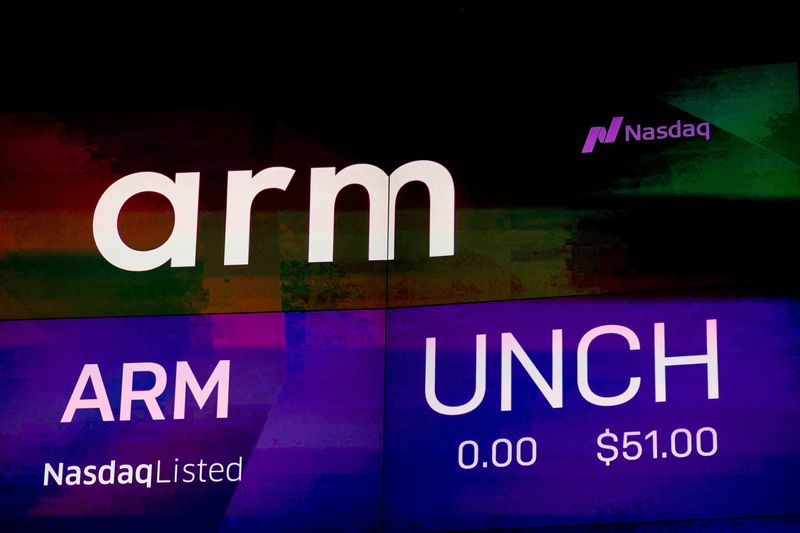By Max A. Cherney and Stephen Nellis
(Reuters) -Arm Holdings gave a full-year revenue forecast on Wednesday that missed the expectations of investors who had sent the chip designer's shares soaring last September following its IPO on optimism around AI.
Shares of Arm fell about 7% in extended trading after the report.
Arm's March-quarter results handily beat expectations but its full-year guidance underscores uncertainty around the pace of the build-out of artificial-intelligence computing and whether investors have lifted AI-related stocks more than is justified by their growth rates.
"The drop is because of the outlook. Arm is priced for outperformance, not this," Summit Insights analyst Kinngai Chan said.
Shares of other AI chipmakers dipped after Arm's report, with Nvidia (NASDAQ:NVDA) and Advanced Micro Devices (NASDAQ:AMD) each down about 0.5%.
For the current fiscal first quarter, Arm forecast revenue in a range between $875 million and $925 million, with a midpoint of $900 million, compared with an average analyst estimate of $857.5 million, according to LSEG data.
The UK chip designer also said it expects full-year revenue between $3.8 billion and $4.1 billion, with a midpoint of $3.95 billion. That compares with a consensus estimate of $3.99 billion.
Arm forecast full-year earnings per share between $1.45 and $1.65, compared with average analyst estimates of $1.54.
"I wanted to make sure we set a target that ties to what we have high confidence in to what we can deliver," Arm's finance chief, Jason Child, told Reuters in an interview. The timing of some of the company’s licensing deals, he added, can be “hard to pin down,” which is why the company issues a range for guidance.
Bets that Arm will benefit from a surge in AI computing have doubled the chipmaker's share price since its initial public offer last September, giving it a market value of about $110 billion.
Its shares recently traded at nearly 70 times expected earnings, compared with 35 times earnings for heavyweight chipmaker Nvidia, according to LSEG data.
Arm's fourth-quarter revenue rose 47% to $928 million, compared with analyst estimates of $875.6 million.
Arm generates revenue from licensing fees for its semiconductor designs and collects a royalty for each chip sold that uses its technology.
It struck four major licensing agreements during the quarter, which is why that segment grew substantially, Child said. The royalties business benefited from a new Arm design that commands a higher rate, and now accounts for 20% of the segment, growing 5 percentage points.
Arm's designs power nearly every smartphone in the world, and the company has attempted to make headway in data centers and other markets. Chips with Arm technology generate $200 billion a year of revenue for the many chipmakers that sell them, according to research from TD Cowen.
The company's licensing business grew 60% to $414 million in the fourth quarter compared with the year-ago period, and its royalty segment jumped 37% to $514 million.
Arm reported fourth-quarter earnings of 36 cents per share, adjusted for stock-based compensation, among other things.

That beat the consensus estimate of 30 cents per share.
Though Arm's designs are found adjacent to chips that power AI applications, the company's revenue and profit have not benefited from AI to the same degree as Nvidia's.